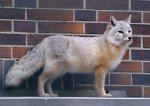 The Corsac Fox (Vulpes corsac) lives in the steppes and semi-desert of Central Asia. It does not dig its own burrows, but most of the time it takes over other animals' burrows. It is more social than other foxes and might even live together with other Corsac foxes in a burrow. Nocturnal in the wild, in captivity they are more active during the day. It is speculated that they have become more nocturnal in the wild, because of humans hunting the Corsac Fox, forcing it to become nocturnal. Their carnivorous diet mainly consists of rodents, pikas, birds and insects. They have a characteristic way to catch their favourite prey, rodents, by jumping in the air and dropping down on their prey.
The Corsac Fox (Vulpes corsac) lives in the steppes and semi-desert of Central Asia. It does not dig its own burrows, but most of the time it takes over other animals' burrows. It is more social than other foxes and might even live together with other Corsac foxes in a burrow. Nocturnal in the wild, in captivity they are more active during the day. It is speculated that they have become more nocturnal in the wild, because of humans hunting the Corsac Fox, forcing it to become nocturnal. Their carnivorous diet mainly consists of rodents, pikas, birds and insects. They have a characteristic way to catch their favourite prey, rodents, by jumping in the air and dropping down on their prey. Picture of the Corsac Fox by F. Spangenberg, licensed under GNU Free Documentation License.
The Corsac fox, corsac is listed as Least Concern. Does not qualify for a more at risk category. Widespread and abundant taxa are included in this category, on the IUCN Red List of Threatened Species
Namings for the Corsac fox
A young / baby of a Corsac fox is called a 'cub, kit or pup'. The females are called 'vixen' and males 'reynard, todd or dog'. A Corsac fox group is called a 'leash or skulk'.Countries
Afghanistan, China, India, Iran, Kazakhstan, Kyrgyzstan, Mongolia, Pakistan, Russia, Turkmenistan and UzbekistanCorsac fox habitats
Desert, Grassland, Shrubland, Temperate Desert, Temperate Grassland and Temperate ShrublandSome facts about the
Corsac fox
Adult weight : 2.7 kg (5.94 lbs)
Maximum longevity : 13 years
Female maturity :504 days
Gestation : 53 days
Weaning : 28 days
Litter size : 5
Weight at birth : 0.063 kg (0.1386 lbs)

Custom Search